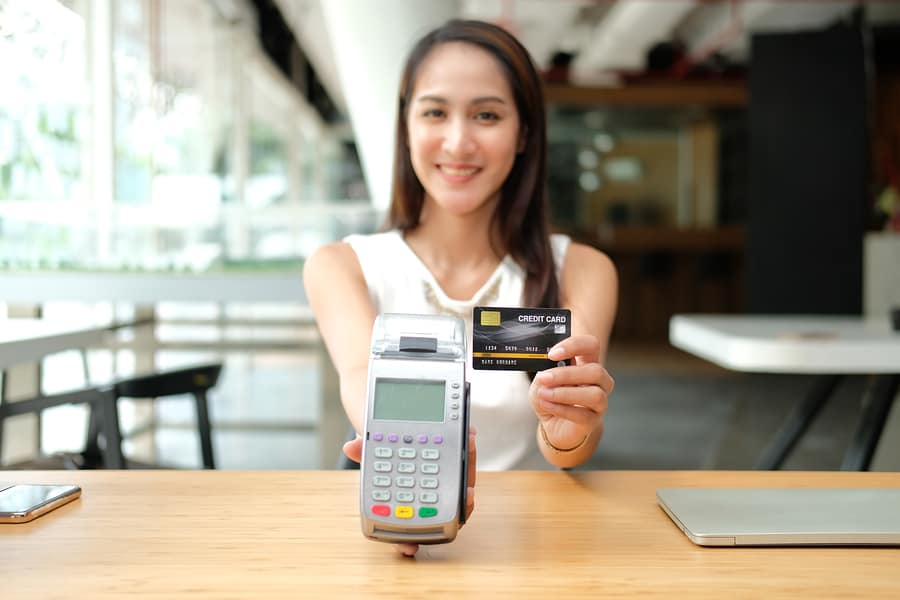How To Choose A Credit Card Machine Or Payment Terminal
As more customers are using plastic to pay for purchases, equipping your business with a credit card machine is crucial. Learn more about the six types of credit card machines and how to choose the right one for your business.

A credit card machine is hardware used to read credit cards and may also be referred to as readers, payment terminals, POS systems, or smart terminals.
Choosing the right credit card machine can be challenging for brick-and-mortar business owners who are forced to sift through the overwhelming number of payment terminals on the market.
Fortunately, this guide takes a deep dive into credit card machines, including the different types of payment terminals and how to choose the best one for your business.
Table of Contents
What Are Credit Card Machines?
Credit card machines are the hardware that is used to accept payments from customers using debit or credit cards. Credit card machines are also referred to as payment terminals, credit card readers, or POS hardware.
Traditional credit card machines are recognizable from their PIN pads, card swiping or insert slots, or plastic pen used to collect signatures.
However, not all credit card machines have these features. The key feature of credit card machines is the ability to read and send card information during a transaction.
How Do Payment Terminals Work?
A payment terminal is the starting point of a debit or credit card transaction. Customers swipe, tap, or insert their card into the payment terminal’s hardware. In this interaction, the payment terminal collects the customer’s card information and sends that data to your payment processor or bank via the internet.
Your processor will send a request for payment to the customer’s card network, which will in turn check to see whether the customer has enough funds to cover the transaction. If the customer is good for the payment, they’ll be asked to sign or enter their Personal Identification Number (PIN) code to securely verify their acceptance of the transaction.
After this step, the transaction is completed from the customer’s perspective. However, merchants must wait for the completion of the submission and settlement transaction stages to receive their funds. The entire process takes several days, after which settled funds will appear in your business’s merchant account.
As long as you do the work of preventing chargebacks, you’ll likely see very few interruptions to your business’s cash flow.
Types Of Credit Card Machines & Terminals
| Credit Card Machine Types | Features | Best For |
|---|---|---|
| Traditional Payment Terminals | Basic hardware with a wired internet connection | Brick-and-mortar retail shops |
| Smart Terminals | Touch screen hardware, usually with NFC payment acceptance for tap-and-go transactions | Contactless payments and speedy checkouts |
| Mobile Swipers & Card Readers | Basic hardware with simple card reading functionality | New businesses or as a supplement to a POS integrated terminal |
| Wireless Credit Card Machines | Wi-Fi Connected wireless hardware | Mobile businesses, such as food trucks or festival stalls |
| Integrated Credit Card Machines | Multiple payment terminal options that integrate with POS software | Any business looking to integrate their payment terminal with POS software |
| Virtual Terminals | No hardware needed, card info is entered via web browser or app | eCommerce businesses |
There are several types of credit card machines available, including traditional payment terminals, wireless credit card machines, mobile swipers, card readers, smart terminals, virtual terminals, and integrated credit card machines. Let’s take a look at the different types of credit card machines for small businesses.
Credit Card Machines VS POS
Functionality is the primary difference between a credit card machine and POS, with credit card machines being limited to payment acceptance and POS systems have broader applications including cash acceptance, item scanning, timeclock hardware, and inventory management.
Additionally, a POS system will include credit card machines, while credit card machines are considered standalone products that don’t typically need POS software support.
How To Choose The Right Credit Card Machine Or Payment Terminal For Your Business
To choose the right credit card machine or terminal for your business, consider which payment processor would best suit your business, what features you’re looking for, cost, and POS software integration options.
Here’s a breakdown of which factors to consider when choosing the best credit card machine for your business.
Choosing The Right Payment Processor
It is essential to find a good processor and then look at hardware offerings instead of the other way around. Some of the really good processors will even let you buy or bring your old machines when you sign up with them. Then, for a small fee or sometimes for free, they can reprogram the machines to work with their backend software.
Depending on your particular situation, consider doing one of the following:
- If you already have a credit card machine/POS system, ask your hardware provider for a list of processors that use software compatible with your hardware. This way, you make sure that your existing hardware can be re-used.
- If you really want an integrated system, shop around. Many payment processors offer Clover, but the contract terms and pricing markups for the hardware can vary quite a bit. We also strongly recommend against leasing your payment processing hardware, which unfortunately is still a common practice, especially with Clover.
- If you don’t know or don’t care too much about the hardware, find a good payment processor with low credit card processing fees. They will talk you through your specific needs and make sensible suggestions from their available options.
Card Reader Capability
The card reader should be capable of reading EMV (i.e., chip) cards because EMV readers reduce your fraud liability. Fortunately, most card readers have that capability these days, and only a few readers are magnetic stripe readers only. NFC reading capability for electronic wallets such as Apple Pay or Google Pay is nice to have, but not as essential as EMV.
Cost Of Credit Card Machines & Your Budget
Figure out your budget for the machine and stick to it. Credit card machines run the gamut in prices, from completely free to $1,000+. The difference between the two is the same as the difference between driving a luxury car and a subcompact — they will both get you from point A to point B, but only one of them will give you a journey catered to your comfort and convenience.
For credit card machines, the difference often comes down to the type of software loaded into the machine — a machine loaded with modern POS software can provide a lot of convenience for a busy business owner.
With some third-party processors such as Square, not only do you get a free reader, you can use many aspects of their POS software for free. So, before you settle on a machine, be sure to consider your business’s hardware and software needs as a whole, both for now and several years from now.
Integration With POS Software
Elaborating a little more on the POS software, you might want to consider whether and how well you wish to integrate your card terminal with any POS software. Basically, this comes down to convenience and the type of business you run. Automatically syncing the card authorization with the payment submission after a transaction can save you a little bit of time (often just a matter of punching an extra button, but this can get tedious if you have a line of customers).
If your business takes just a few payment card charges every day or even every hour, then automatically syncing your sales with sales reports and inventory might not be important. But if you have a lot of customers every day, the syncing ability could save you a lot of time with the administrative work/daily bookkeeping for your business.
The Bottom Line On Credit Card Machines
Credit card machines are just hardware that take information from cards and forward it to your processor. They’re important, but within the same type of card machine, there isn’t a lot of variety in terms of security features and functionality.
In fact, there are more merchant services providers with more variance in pricing, contract terms, and quality of customer service than there are credit card machine manufacturers. If you look carefully, many of these providers offer the same hardware at different prices.
What’s most important is your credit card processor, which will ultimately allow your business to accept credit card payments and get paid. Fortunately, the best credit card payment processing companies offer extensive support for multiple credit card machine types, prices for every budget, and POS integration options.
If you’d like to take a credit card machine-first approach, the best credit card machines and terminals offer a range of hardware options, POS integration options, affordability, and multiple ways to accept payments for your business.











